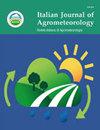Shertered horticulure adapted to different climate zones in Radhort Countries
IF 0.8
4区 农林科学
Q2 AGRONOMY
Italian Journal of Agrometeorology-Rivista Italiana Di Agrometeorologia
Pub Date : 2023-01-29
DOI:10.36253/ijam-1655
引用次数: 0
Abstract
Over the last decade, the total population of the sub-Saharan region of Africa has been increasing rapidly at a rate of more than 3% annually, with urbanization expected to be approximately 40% of the total population by 2050. Parallel growth has not been achieved in the agricultural sector in West Africa, with vegetable production and consumption being amongst the lowest in the world. This has aggravated the already food insecurity and malnutrition situation in the region. In this context, and within the framework of their agricultural development policies, 10 countries of West Africa (Burkina Faso; Cabo Verde; Côte d’Ivoire; Guinée; Guinée Bissau; Mali; Mauritanie; Niger; Sénégal; Chad), established the “African Network for Horticultural Development “RADHORT” (Réseau Africain pour le Développement de l’Horticulture), in order to cooperate for the diversification and intensification of horticulture in the region. The countries of RADHORT cover different climate zones ranging from the arid climate (desert), to the Sahelian zone (semi-arid), to the dry tropical zone (with long dry season and short rainy season), and to the wet tropical zone (humid zone with bimodal rainfall). Temperatures and global radiation are very suitable for vegetable production in tropical countries throughout the year, but open air cultivation can be severely hampered by high temperatures, winds, heavy rainfall, while being exposed to pest and disease infestation. Sheltered cultivation will help to moderate negative effects of climate factors on the crop, improve water productivity and the efficiency of eco-friendly pest and disease management. The paper analyses and discusses different technical options of sheltered cultivation to be tested in RADHORT countries, as a means to enhance horticulture crops productivity and quality for meeting the growing demand of an expanding rural and urban population.适应不同气候带的遮阳园艺
在过去十年中,非洲撒哈拉以南地区的总人口以每年3%以上的速度快速增长,预计到2050年,城市化将占总人口的40%左右。西非农业部门没有实现平行增长,蔬菜生产和消费是世界上最低的。这加剧了该地区本已存在的粮食不安全和营养不良状况。在这方面,在其农业发展政策框架内,西非10个国家(布基纳法索、佛得角、科特迪瓦、几内亚、几内亚比绍、马里、毛里塔尼亚、尼日尔、塞内加尔、乍得)建立了“非洲园艺发展网”,以便为该地区园艺的多样化和集约化进行合作。RADHORT的国家涵盖不同的气候区,从干旱气候(沙漠)到萨赫勒地区(半干旱),到干旱热带地区(旱季长雨季短),再到潮湿热带地区(双峰降雨的潮湿地区)。温度和全球辐射非常适合热带国家全年的蔬菜生产,但露天种植可能会受到高温、大风和强降雨的严重阻碍,同时也会受到病虫害的侵扰。遮蔽栽培将有助于缓和气候因素对作物的负面影响,提高水生产力和生态友好型病虫害管理效率。本文分析并讨论了将在RADHORT国家测试的不同庇护种植技术选择,作为提高园艺作物生产力和质量的一种手段,以满足不断扩大的农村和城市人口日益增长的需求。
本文章由计算机程序翻译,如有差异,请以英文原文为准。
求助全文
约1分钟内获得全文
求助全文
来源期刊

Italian Journal of Agrometeorology-Rivista Italiana Di Agrometeorologia
AGRONOMY-ENVIRONMENTAL SCIENCES
CiteScore
2.10
自引率
8.30%
发文量
6
期刊介绍:
Among the areas of specific interest of the journal there are: ecophysiology; phenology; plant growth, quality and quantity of production; plant pathology; entomology; welfare conditions of livestocks; soil physics and hydrology; micrometeorology; modeling, simulation and forecasting; remote sensing; territorial planning; geographical information systems and spatialization techniques; instrumentation to measure physical and biological quantities; data validation techniques, agroclimatology; agriculture scientific dissemination; support services for farmers.
 求助内容:
求助内容: 应助结果提醒方式:
应助结果提醒方式:


